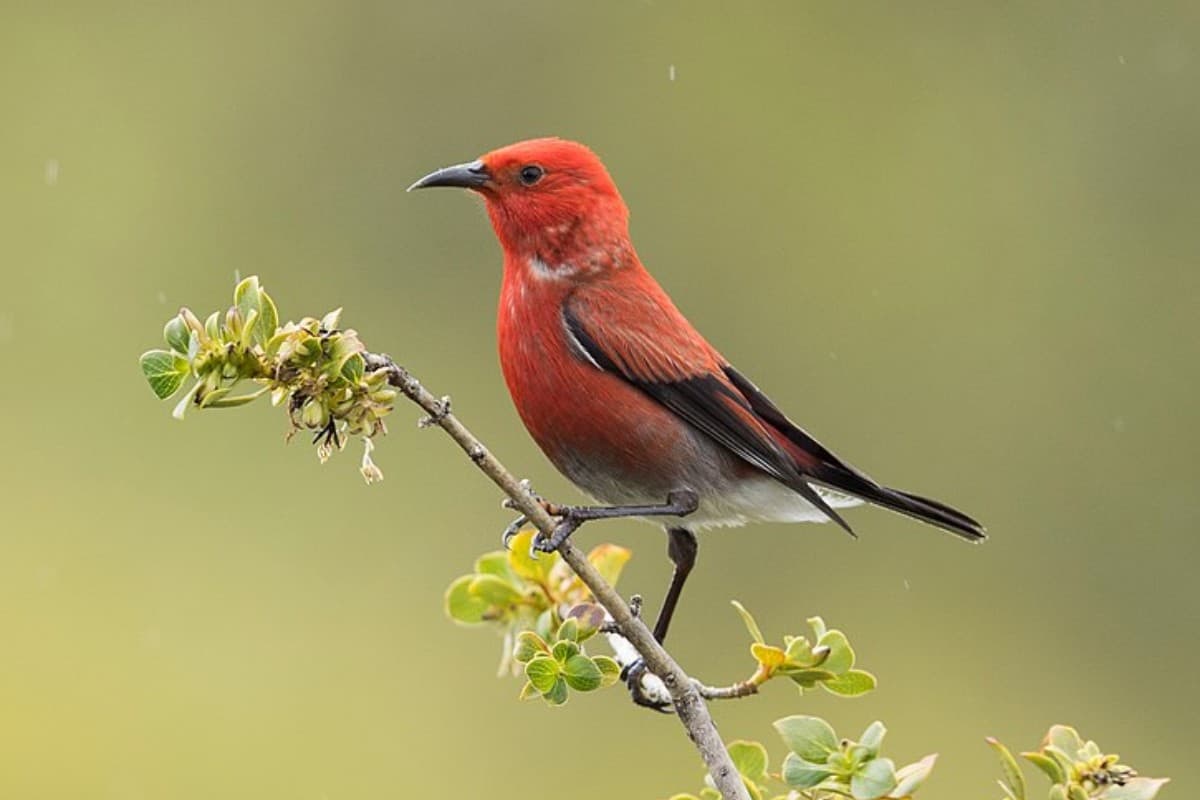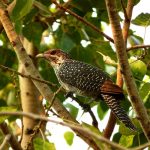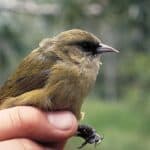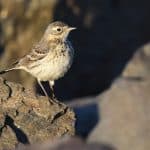Apapane | image by MFBRP via Wikimedia Commons | CC BY-SA 4.0
Common Name: ʻApapane
Scientific Name: (Himatione sanguinea)| Size | Diet | Range in Hawaii | Status in Hawaii |
|---|---|---|---|
| 5 in. | nectar | Big Island Maui, Kaua'i, O'ahu, Moloka'i, and Lana'i | Least Concern |
The ʻApapane, also known as the Hawaiian Honeycreeper, is a small bird species that is native to the Hawaiian Islands. Endemic to Hawaii, the ʻApapane is a beloved sight among birdwatchers and a symbol of the islands’ unique biodiversity. With its bright red plumage and melodious singing, the ʻApapane is one of the most recognizable bird species in Hawaii.
In this article, we will explore the fascinating world of the ʻApapane, its unique characteristics, and its presence in Hawaii.
ʻApapane
Appearance

The ‘Apapane is a visually striking bird with vibrant plumage. It measures approximately 5 inches in length, making it a relatively small species. The adult ‘Apapane has a distinctive appearance, characterized by its bright crimson feathers. The plumage of males and females is similar, displaying a deep crimson coloration throughout the body, including the head, back, wings, and tail.
In addition to their vivid crimson feathers, ‘Apapanes has a slightly curved black bill and dark-colored legs. They have short wings and a relatively long tail, which adds to their overall agile and graceful appearance. The ‘Apapane’s small size and colorful plumage make it an eye-catching bird as it flits through the forests of Hawaii.
It is worth noting that juvenile ‘Apapanes have a different appearance compared to adults. They have a duller coloration, with brownish feathers and a less pronounced crimson hue. However, as they mature, their plumage gradually transitions to the vibrant crimson of the adults.
Diet
The ‘Apapane has a specialized diet that primarily consists of nectar from various flowering plants. It is particularly adapted to feed on the abundant blooms of the ‘ohia lehua (Metrosideros polymorpha), a native tree species found in the Hawaiian forests. Using its specially adapted bill, the ‘Apapane inserts its slender, curved bill into the tubular flowers to access the nectar within.
While nectar forms a significant part of their diet, ‘Apapanes also consume small insects and spiders, especially during the breeding season when they require additional protein for raising their young. They may catch these invertebrates while foraging within the forest canopy or by gleaning them from leaves and branches.
The ‘Apapane’s feeding behavior is often observed as they hover near flowers, using their long bills to reach deep into the floral tubes to extract nectar. Their specialized beak allows them to access nectar from a wide range of flowers, making them important pollinators for various plant species.
Nesting
The ‘Apapane constructs intricate and well-crafted nests for breeding purposes. These nests are typically cup-shaped and built using a combination of materials such as twigs, plant fibers, moss, and lichens. The female ‘Apapane takes the primary responsibility for nest building, using her beak to weave and interlace the materials together.
Nesting sites for ‘Apapanes are commonly found in the dense foliage of ‘ohia lehua trees or other native trees within the Hawaiian forests. The location of the nest provides protection and camouflage for the eggs and nestlings. It also offers a suitable vantage point for the parents to monitor their surroundings.
The female ‘Apapane lays a clutch of two to three eggs, which are typically white with small reddish speckles. Both parents take turns incubating the eggs, sharing the responsibility of keeping them warm and protected. Incubation lasts for about 13 to 15 days, after which the eggs hatch.
Once the eggs hatch, the parents continue to work together to feed and care for the nestlings. They gather nectar and small insects to provide a balanced diet for their growing offspring. The nestlings remain in the nest for around 15 to 21 days, during which time they develop their feathers and gain strength.
After the fledglings are fully developed and capable of flight, they leave the nest, although the parents may still provide them with food and guidance for a period of time. ‘Apapanes often have multiple broods throughout the breeding season, allowing them to raise multiple generations of young each year.
Behavior
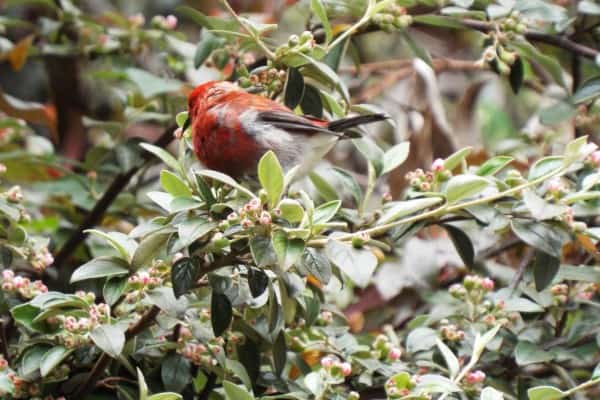
The ‘Apapane exhibits fascinating behaviors that contribute to its survival and adaptation in the Hawaiian ecosystem. These birds are nectarivores, primarily feeding on nectar from tubular flowers.
With their specialized bills, they can access the sweet reward inside the blossoms. ‘Apapanes play a crucial role in pollination as they visit various flowers, unintentionally transferring pollen and aiding in the plant’s reproduction. In addition to nectar, they also consume small insects and spiders, especially during the breeding season.
When it comes to foraging, ‘Apapanes display agility and precision. They are skilled fliers, capable of hovering and maneuvering through the dense forest canopy.
These birds actively search for nectar-rich flowers, swiftly moving from tree to tree. Their flights are characterized by swift and direct movements, occasionally punctuated by bursts of speed.
One notable aspect of ‘Apapane behavior is their enchanting vocalizations. They possess a range of calls, including sweet trills, buzzing notes, and soft chirps. These vocalizations serve as a means of communication between individuals, marking territory boundaries, and engaging in courtship displays.
Seasonal migrations are another remarkable behavior observed in ‘Apapanes. Like other Hawaiian honeycreepers, they undertake seasonal movements, often commuting between different elevations or even between islands. These movements are influenced by the availability of flowering plants and the production of nectar, as they seek out suitable food resources.
During the breeding season, male ‘Apapanes engage in elaborate courtship displays to attract females. These displays involve aerial chases, flapping displays, and their vibrant plumage is prominently showcased.
Socially, ‘Apapanes are typically observed in small groups or pairs. They can be territorial, defending their feeding and nesting territories from other individuals. However, they may tolerate the presence of conspecifics during abundant food resources or when gathering in communal feeding areas.
Habitat
The ‘Apapane primarily inhabits the native montane forests of the Hawaiian Islands. These forests are characterized by their lush vegetation, diverse plant species, and varying elevations. ‘Apapanes are specifically adapted to the upper-elevation habitats, typically found at higher elevations.
They are closely associated with the ‘ohi’a lehua tree, which is a dominant tree species in these montane forests. The ‘ohi’a lehua provides an abundant source of nectar, which is a vital food resource for the ‘Apapane. This species relies heavily on the nectar from the ‘ohi’a lehua flowers for its survival.
The ‘Apapane’s habitat consists of a mosaic of diverse vegetation types, including native forests, open clearings, and understory shrubs. They prefer areas with a dense canopy cover that provides ample cover and protection. These habitats often have a rich understory with a variety of flowering plants, which further supports the ‘Apapane’s nectar-feeding behavior.
Range
The ‘Apapane is a native bird species found in the Hawaiian Islands. It has a widespread distribution and can be observed on all six of the forested islands: Hawai’i, Maui, Kaua’i, O’ahu, Moloka’i, and Lana’i.
The ‘Apapane is well-adapted to the diverse habitats of Hawaii, including montane and subalpine forests. It is primarily associated with the upper-elevation regions where the dominant native tree species, ‘ohia lehua (Metrosideros polymorpha), thrives.
Within its range, the ‘Apapane can occupy a variety of elevations, from lowland forests to higher elevations reaching over 1,000 meters. It is commonly encountered in the lush, forested areas of these islands. However, there may be variations in its abundance and distribution across different islands, with some populations experiencing declines in certain areas.
Conservation Status
The ‘Apapane (Himatione sanguinea) is currently listed as a species of least concern on the IUCN Red List. While the population of ‘Apapanes remains relatively stable, they do face some threats to their conservation. The primary concern is the loss and degradation of their native montane forest habitat due to deforestation, invasive species, and habitat fragmentation.
Interesting Facts
1. Unique feather structure
The feathers of the ‘Apapane are specialized to reflect and scatter light, giving them a striking iridescent appearance.
2. Remarkable song repertoire
Male ‘Apapanes have a diverse and complex song repertoire consisting of melodious trills, warbles, and chirps.
3. Flexible nesting sites
These birds build cup-shaped nests using plant fibers, lichens, and moss, often selecting a variety of tree species as nesting sites.
4. Decline in population
Despite their abundance, ‘Apapane populations have experienced declines due to habitat loss, avian diseases, and the spread of non-native species.
Frequently Asked Questions
1. How long do ‘Apapanes live?
‘Apapanes have a relatively long lifespan for their size, with individuals known to live up to 12 years or more in the wild.
2. Are ‘Apapanes social birds?
‘Apapanes are generally solitary birds, but they may form loose flocks during non-breeding periods when food resources are abundant.
3. Can ‘Apapanes imitate other bird calls?
No, ‘Apapanes do not possess the ability to mimic other bird calls. They have their own unique vocalizations that are used for communication and territorial defense.
